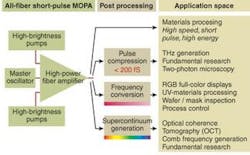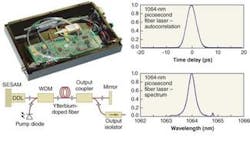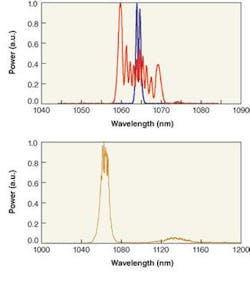JOHN CLOWES and ANATOLY GRUDININ
Although ultrafast applications have been dominated by bulk solid-state lasers over the past 30 years, this trend looks set to change. Fiber lasers, with their compact size, high efficiency, and maintenance-free operation, are ideally positioned to replace and make redundant bulk solid-state lasers in many application areas, including precision materials processing, fundamental research, semiconductor inspection, and homeland security, to name but a few. Furthermore, with their ease of manufacture, ultrafast fiber lasers have high potential to meet the requirements of mainstream applications yet to be explored because of a lack of suitable technology.
The fiber MOPA
The most obvious candidates to challenge solid-state dominance are fiber lasers based on ytterbium (Yb)-doped fiber. Ytterbium-doped fiber lasers and amplifiers operate over a wide spectral range including the common wavelength of 1064 nm. The broad absorption band around 976 nm permits optical pumping of Yb-doped fibers with high-power, telecom-rated laser diodes, achieving optical conversion efficiencies close to the theoretical limit.
One of the most fortunate features of fiber amplifiers—both erbium (Er)-doped and Yb-doped—is a high gain combined with a low noise figure. This allows the use of master-oscillator-power-amplifier (MOPA) configurations in which a low-power master source is followed by a high-gain, high-power fiber amplifier, allowing the parameters of both the master source and power amplifier to be independently tailored (see Fig. 1).
The master source
Fiber lasers have a natural ability to produce and maintain ultrashort optical pulses; several methods can be used to achieve this.1 The situation becomes particularly favorable for short-pulse generation when the laser operates in the soliton regime, where the balance between anomalous dispersion and nonlinearity enables the generation of optical solitons-stable, nonlinear pulses with fixed energy.
In the past, the soliton regime of operation has been limited to Er-doped fiber lasers operating within the wavelength region of anomalous dispersion of standard optical-fiber waveguides—typically greater than 1300 nm. However, using the ongoing developments in fiber technology, dispersion-tailored photonic-crystal fibers with anomalous dispersion at 1064 nm now enable the generation of optical solitons in this region of the spectrum.
To make systems compact, environmentally stable, and self-starting, the most practical design of passively modelocked lasers is based on the use of semiconductor saturable absorbers—an intensity-discriminating element within the laser cavity that initiates modelocking and shapes the optical pulses. This idea was first implemented in the early 1970s in semiconductor lasers and later adopted for solid-state and fiber lasers.2, 3, 4
The use of a semiconductor saturable-absorber mirror as one of the fiber-cavity mirrors allows for very simple, all-fiber cavity designs (see Fig. 2). The low powers of these cavities, along with the use of telecom-grade components, result in high system reliability and unprecedented pulse-to-pulse stability—essential features when seeding high-power amplifiers.Ultrashort-pulse amplification
Amplifying ultrashort optical pulses to energies and peak powers comparable to those of solid-state lasers requires cladding-pumped fiber technology—a simple and elegant way to scale single-fiber power up to a few kilowatts.5 In the cladding-pumped configuration, an Er- or Yb-doped core is surrounded by a cladding layer that is heavily multimode at the pump wavelength and is surrounded by an outer cladding layer of still-lower refractive index. Absorption of the pump by the rare-earth ions in the core and subsequent lasing converts the high-power, low-brightness semiconductor-pump-laser input into intense diffraction-limited laser output.
The design of a cladding-pumped fiber involves a compromise between launch efficiency—helped by a larger cladding-waveguide dimension—and pump rate, which requires smaller cladding waveguides. The high surface-area-to-volume ratio of the fiber geometry effectively eliminates thermal problems that are a critical limiting factor in bulk high-power lasers.
In CW-laser applications, the device length of a cladding-pumped amplifier is not a critical parameter and tens of meters can be tolerated. For amplification of ultrashort pulses, however, it is often desirable to minimize spectral distortion of the amplified pulses. The main culprit in this instance is the third-order fiber nonlinearity, in which the Kerr effect is responsible for self-phase modulation (SPM) and Raman gain results in the breakup of short optical pulses at high energies through stimulated Raman scattering (SRS; see Fig. 3).Using fiber nonlinearity
In some cases, fiber nonlinearity plays to our advantage. For example, during amplification in normal-dispersion fiber, low-intensity transform-limited pulses become spectrally broad because of SPM and acquire nearly linear spectral chirp. Such pulses can then be compressed down to below 150 fs in fiber or bulk compressors.6
Pulses with energies of a few hundred nanojoules, peak powers in excess of a megawatt, and pulse widths below 150 fs can be delivered by these commercially available fiber-laser sources. Furthermore, these lasers provide diffraction-limited beam quality and maintenance-free turn-key operation with footprints of an order of magnitude smaller than those of comparable Ti:sapphire sources. As such, fiber lasers from Fianium are finding numerous applications, from precision materials processing to fundamental research using multiphoton-excitation microscopy.
Minimizing fiber nonlinearity
In many other applications, such as frequency upconversion to the visible and UV, it is important to minimize the nonlinear effects within the amplifier. Fiber nonlinearity, which scales with increasing optical intensity and fiber length, can be reduced through the technique of chirped-pulse amplification, involving dispersively stretching and recompressing the pulse before and after amplifying. However, such schemes require additional system complexity.
The alternative approach to reducing nonlinear effects is based on the modification of fiber parameters to minimize spectral distortion. The most straightforward way to minimize both SPM and SRS is to increase the doped core area while at the same time retaining the single-transverse mode. Besides decreasing intensity and alleviating detrimental effects of fiber nonlinearity, a larger mode area (LMA) also helps in the generation of high-energy pulses because maximum pulse energy scales with the core area. The first experimental results in LMA fibers were published in 1997, in which a complex refractive-index profile gave rise to a core area as high as 275 µm2 versus 40 to 60 µm2 in standard fibers.7 Using this approach but with somewhat less-complex refractive-index profiles and improved fiber-fabrication techniques, several research groups have demonstrated LMA fibers with core areas in excess of 1000 µm2.
Device length can be further reduced by reducing the inner (pump) cladding area. In many cases, the inner cladding diameter is around 140 to 400 µm2, which is dictated by both the pump-launching method and the type of pump sources used. Clearly, to minimize device length, high-brightness pump sources are essential; for this kind of application, multi-emitter assemblies look most attractive.
Using spatial combination of the output of several high-power multimode laser diodes, it is possible to efficiently couple the combined power into a single delivery fiber with core diameter comparable to the size of the emitter. Commercially available pump modules, such as the PUMA (pump module for advanced applications), can deliver in excess of 20 W from a compact package, ideal for integration into high-power fiber-amplifier and MOPA systems.
The combination of LMA amplifier fiber and high-brightness pumps allows us to build efficient fiber amplifiers while minimizing the nonlinear effects.
Covering the optical spectrum
Low-nonlinearity amplifiers are particularly important for nonlinear frequency conversion to the visible and UV. For efficient frequency conversion, it is essential to maintain a narrow spectral bandwidth within the acceptance bandwidth of the nonlinear optical crystal. Using short-length fiber amplifiers and high-brightness pump modules, pulses with peak powers of tens of kilowatts are achievable with narrow optical spectra (see Fig. 3).
From high-power 1064-nm fiber MOPA sources with short-length amplifiers, more than 8 W at 532nm, 4 W at 355nm, or 1 W at 266 nm are available through second, third, and fourth-harmonic generation in standard nonlinear frequency converters.
New challenges, new horizons
The ongoing push toward miniaturization in electronics and optoelectronics is expanding the roles of high-power UV lasers in semiconductor and microelectronics processing and in process control. With its low-cost, compactness and high-reliability, ultrafast-fiber-laser technology appears to be a clear choice for next-generation inspection systems.
While fiber systems can outperform bulk solid-state systems in many application areas, perhaps the biggest challenge facing ultrafast-fiber-laser development will be to address those outliers—the applications in which the bulk solid-state laser is the only existing option. Millijoule ultrafast fiber sources, pulse durations of a few femtoseconds, and wavelength-tunable femtosecond fiber lasers may finally prove that fiber lasers really can do anything solid-state lasers can; this may happen sooner than we expect.
REFERENCES
1. M. E. Fermann, Ultrafast fiber oscillators, in “Ultrafast lasers. Technology and applications,” Marcel Dekker, 2003.
2. L.R. Brovelli et al., JOSA B 12, 311 (1995).
3. M. Zirngibl et al., Electron. Lett. 27, 1734 (1991).
4. Okhotnikov et al., Phot. Tech. Lett. 15(11) 1519 (Nov. 2003).
5. V. P. Gapontsev et al., Proc. CLEO 2003, post deadline paper CThPDB9 (2003).
6. J. Limpert et al., Optics Express 11(24), 3332.
7. D. Taverner et al., Optics Lett. 22, 372, (1997).
John Clowes is R&D manager and Anatoly Grudinin is the managing director of Fianium, 20 Compass Point, Ensign Way, Southampton SO31 4RA, England; e-mail: [email protected].


